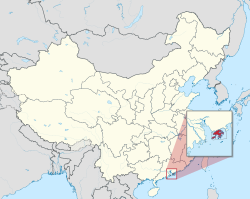
Back Гонконг Abkhazian Hong Kong ACE Hongkong Afrikaans Hongkong ALS Гонконг ALT ሆንግ ኮንግ Amharic Hong Kong AMI Hong Kong AN Hongcong ANG Ọn̄ Kọn̄ ANN
This article needs to be updated. (August 2020) |
Hong Kong | |||||
|---|---|---|---|---|---|
Hong Kong Special Administrative Region of the People's Republic of China
| |||||
 Location of Hong Kong within China | |||||
| Sovereign state | China | ||||
| British possession | 26 January 1841 | ||||
| Treaty of Nanking | 29 August 1842 | ||||
| Convention of Peking | 24 October 1860 | ||||
| New Territories lease | 9 June 1898 | ||||
| Imperial Japanese occupation | 25 December 1941 to 30 August 1945 | ||||
| Sino-British Joint Declaration | 19 December 1984 | ||||
| Handover to China | 1 July 1997 | ||||
| Administrative centre | Tamar | ||||
| Largest district by population | Sha Tin | ||||
| Official languages | |||||
| Cantonese[a] | |||||
| Traditional Chinese[b] English alphabet | |||||
| Ethnic groups (2016) | 92.0% Chinese 2.5% Filipino 2.1% Indonesian 1.1% Indian 0.8% White 0.3% Nepalese 1.6% Others[6] | ||||
| Demonym(s) | Hongkonger | ||||
| Government | Devolved executive-led government within a unitary one-party state[7] | ||||
| John Lee | |||||
| Eric Chan | |||||
| Andrew Leung | |||||
| Andrew Cheung | |||||
| Legislature | Legislative Council | ||||
| National representation | |||||
| 36 deputies | |||||
| 203 delegates[8] | |||||
| Area | |||||
• Total | 2,754.97[9] km2 (1,063.70 sq mi) (168th) | ||||
• Water (%) | 59.70% (1644.79 km2; 635.05 sq mi)[9] | ||||
• Land | 1,110.18 km2 (428.64 sq mi)[9] | ||||
| Highest elevation | 957 m (3,140 ft) | ||||
| Lowest elevation | 0 m (0 ft) | ||||
| Population | |||||
• 2022 estimate | |||||
• 2021 census | |||||
• Density | 6,801[12]/km2 (17,614.5/sq mi) (4th) | ||||
| GDP (PPP) | 2022 estimate | ||||
• Total | |||||
• Per capita | |||||
| GDP (nominal) | 2022 estimate | ||||
• Total | |||||
• Per capita | |||||
| Gini (2016) | high | ||||
| HDI (2021) | very high · 4th | ||||
| Currency | Hong Kong dollar (HK$) (HKD) | ||||
| Time zone | UTC+08:00 (HKT) | ||||
| Date format | dd/mm/yyyy yyyy年mm月dd日 | ||||
| Mains electricity | 220 V–50 Hz | ||||
| Driving side | left[c] | ||||
| Calling code | +852 | ||||
| ISO 3166 code | |||||
| Internet TLD | |||||
| License plate prefixes | None for local vehicles, 粤Z for cross-boundary vehicles | ||||
Hong Kong (/ˌhɒŋˈkɒŋ/ (![]() listen); Chinese: 香港, Hong Kong Cantonese: [hœ́ːŋ.kɔ̌ːŋ] (
listen); Chinese: 香港, Hong Kong Cantonese: [hœ́ːŋ.kɔ̌ːŋ] (![]() listen), literally "Fragrant Port"), officially The Hong Kong Special Administrative Region of The People's Republic of China,[17] is one of two Special Administrative Regions (SARs) of the People's Republic of China (the other is Macau).
listen), literally "Fragrant Port"), officially The Hong Kong Special Administrative Region of The People's Republic of China,[17] is one of two Special Administrative Regions (SARs) of the People's Republic of China (the other is Macau).
It is one of the richest and most developed parts in the world, and one where the cost of living is one of the highest. Hong Kong grew quickly in the decades after World War II, becoming a famous world-class financial centre. Hong Kong was one of the last territories of the British Empire until 1997, when United Kingdom handed it over to China. China then promised to grant it special status for 50 years.
The population of Hong Kong is over seven million. The economy has rapidly grown from a trading port to a very rich city. Hong Kong has the most skyscrapers in the world.
Hong Kong is divided into 3 main parts:
- Hong Kong Island
- Kowloon
- New Territories (including 235 outlying islands)
Hong Kong was a British colony from 1842 to 1997 as China surrendered the city after losing the Second Opium War. After the handover in 1997, Hong Kong became under Chinese control under special status.
Hong Kong has its own constitution that is different from that of the People's Republic of China (PRC).
- ↑ Leung 2016.
- ↑ Official Languages Ordinance.
- ↑ Population By-Census 2016, pp. 31, 51–52
- ↑ Legislative Council Disclaimer and Copyright Notice
- ↑ Use of Chinese in Court Proceedings 2011
- ↑ Population By-Census 2016, p. 46.
- ↑ "China (People's Republic of) 1982 (rev. 2004)". Constitute project. Retrieved 25 August 2019.
- ↑ Cheung 2017.
- ↑ 9.0 9.1 9.2 "Survey and Mapping Office – Circulars and Publications". Survey and Mapping Office. Retrieved 20 October 2020.
- ↑ "Mid-year population for 2022" (Press release). Government of Hong Kong. 11 August 2022. Retrieved 4 September 2022.
- ↑ "Key statistics of the 2021 and 2011 Population Census" (PDF). census2021.gov.hk. Retrieved 15 March 2022.
- ↑ "Main Tables – 2021 Population Census". census2021.gov.hk. Retrieved 15 March 2022.
- ↑ 13.0 13.1 13.2 13.3 "World Economic Outlook Database, October 2022". IMF.org. International Monetary Fund. Retrieved 21 October 2022.
- ↑ Household Income Distribution 2016, p. 7
- ↑ "Human Development Report 2021/2022" (PDF). United Nations Development Programme. 8 September 2022. Retrieved 8 September 2022.
- ↑ Technical Legislative Amendments on Traffic Arrangements for the Hong Kong-Zhuhai-Macao Bridge 2017
- ↑ "Basic Law". www.basiclaw.gov.hk. Retrieved 2021-12-12.
<ref group=lower-alpha> tags or {{efn}} templates on this page, but the references will not show without a {{reflist|group=lower-alpha}} template or {{notelist}} template (see the help page).

